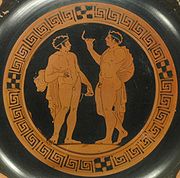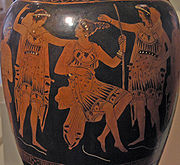
Meleager Painter
Encyclopedia


Ancient Greece
Ancient Greece is a civilization belonging to a period of Greek history that lasted from the Archaic period of the 8th to 6th centuries BC to the end of antiquity. Immediately following this period was the beginning of the Early Middle Ages and the Byzantine era. Included in Ancient Greece is the...
vase painter of the Attic
Attica
Attica is a historical region of Greece, containing Athens, the current capital of Greece. The historical region is centered on the Attic peninsula, which projects into the Aegean Sea...
red-figure
Red-figure pottery
Red-figure vase painting is one of the most important styles of figural Greek vase painting. It developed in Athens around 530 BC and remained in use until the late 3rd century BC. It replaced the previously dominant style of Black-figure vase painting within a few decades...
tradition. He was active in the first third of the 4th century BC. The Meleager Painter followed a tradition started by a group of slightly earlier artists, such as the Mikion Painter. He is probably the most important painter of his generation. He painted a wide variety of vase shapes, including even kylikes
Kylix (drinking cup)
A kylix is a type of wine-drinking glass with a broad relatively shallow body raised on a stem from a foot and usually with two horizontal handles disposed symmetrically...
, a rarity among his contemporaries. His conventional name is derived from several vases depicting hunters, including Atalante
Atalanta
Atalanta is a character in Greek mythology.-Legend:Atalanta was the daughter of Iasus , a Boeotian or an Arcadian princess . She is often described as a goddess. Apollodorus is the only one who gives an account of Atalanta’s birth and upbringing...
and her lover Meleagros. Colonette kraters and bell kraters by him normally bear dionysiac motifs. Like other painters of his time, he liked to paint figures wearing oriental garb. The tondos
Tondo (art)
A tondo is a Renaissance term for a circular work of art, either a painting or a sculpture. The word derives from the Italian rotondo, "round." The term is usually not used in English for small round paintings, but only those over about 60 cm in diameter, thus excluding many round portrait...
inside his kylikes are often framed by wreaths. They mostly depict groups of deities or individual gods. The outsides of kylikes and the paintings on the backs of other vases by him are often of inferior quality.

